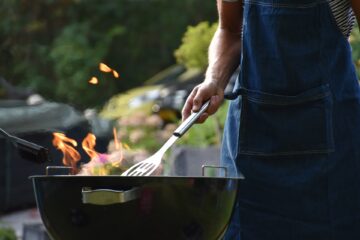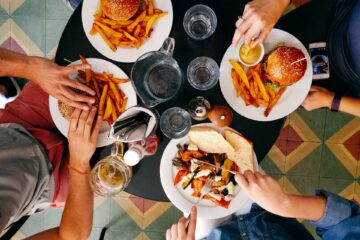Having braces can be a drag. Not only because of how long it would stay on but also for the food restrictions. You might have to take a break from some of your favorites and the ones you can eat will come with some unfair restrictions. However, in the long run, when you are done with your treatment, you would be glad you obeyed the restrictions.
One popular question amongst those who have braces or are about to get braces is ‘can you eat steak with braces’. We will be answering this question with some highlights on some of the things you can and cannot eat with braces.
Can You Eat Steak with Braces?
Yes, you can eat steak with braces, but it is not recommended. You can only have it when it is properly cooked, boneless, soft, and not chewy. You also need to cut it into very small pieces to make it easier to chew; and remember to brush and floss properly after. Avoiding hard or chewy foods that will require extra force from your jaw is essential to the treatment. These kinds of food can damage your braces and send you back to the dentist, they can also lengthen the duration of your treatment or get stuck in your braces.
Getting food out of your braces is never an easy task. It is quite difficult, and if done poorly, you could accidentally break the brackets or wires in your braces. We recommend replacing steak with softer meats like roasted chicken, fish, or pork, which would be easier to chew and remove if they get stuck. It is also advised to avoid sticky or crunchy foods as these will have a harsh effect on your braces as well.
Steak and Braces
Braces can make it difficult to enjoy certain foods, including steak. While it is technically possible to eat steak with braces, there are risks associated with doing so. The texture of steak can make it challenging to chew properly, which can damage the brackets and wires of the braces. Additionally, there is a risk of choking on a piece of steak while eating it. Finally, consuming steak can make cleaning teeth more difficult due to its texture, which can lead to the buildup of food particles around the braces, increasing the risk of cavities and gum disease.
If you still want to enjoy a steak while undergoing orthodontic treatment, it is crucial to take extra care when eating. Cutting the meat into small pieces can make it easier to chew, minimizing the risk of dislodging a bracket or wire. It is also important to chew the steak slowly and carefully, using the back teeth, to prevent damage to the braces. It’s best to avoid biting into the steak with the front teeth or pulling the meat off the bone with the front teeth, as this can cause damage to the braces.
After eating, rinse the mouth with water or mouthwash to remove any food particles that may have accumulated around the braces. It’s important to be diligent about oral hygiene while undergoing orthodontic treatment, and this includes brushing and flossing regularly to remove any food particles that may be trapped in the braces.
Alternatives to Eating Steak with Braces
If you’re wearing braces, you may be wondering what types of foods are safe to eat. While steak may be off-limits, there are plenty of alternatives that are both safe and delicious.
Soft foods are an excellent option for those with braces, as they won’t cause any damage to the brackets and wires. Cooked vegetables like sweet potato, carrots, and squash are all great choices, as are soft fruits like bananas, melons, and avocados. Soups and stews with tender meat and vegetables are also gentle on the braces.
In addition to soft foods, it’s important to focus on nutrient-rich foods that promote dental health. A healthy diet is essential for maintaining good oral health, and some essential vitamins and minerals for healthy teeth and gums include calcium, vitamin D, vitamin C, and phosphorus. Dairy products like milk, yogurt, and cheese are rich in calcium and phosphorus, which are essential for strong teeth and bones. Leafy greens like kale and spinach are high in calcium and vitamin C, which help strengthen tooth enamel and gum tissue. Fruits like strawberries and citrus fruits are rich in vitamin C, which helps prevent gum disease. Nuts and seeds like almonds and pumpkin seeds are also excellent sources of phosphorus and calcium.
If you’re looking for a protein source other than steak, fish and seafood like salmon, tuna, and shrimp are excellent options. They are high in protein and omega-3 fatty acids, which promote healthy gums and teeth. Beans and lentils are also high in protein and fiber, which help maintain healthy blood sugar levels and promote good oral health. Tofu and other soy products are rich in protein and calcium, which are essential for strong teeth and bones. Chicken, turkey, and pork are softer and easier to chew than steak, making them safer options for those with braces.
Maintenance of Braces
Maintaining good oral hygiene is crucial when you’re wearing braces. Braces create more nooks and crannies in the mouth where food particles and bacteria can accumulate, leading to decay and gum disease. Braces also make it harder to brush and floss properly, as the wires and brackets can get in the way.
Regular orthodontic checkups are crucial to maintain good oral health. Your orthodontist can detect problems early and recommend the best course of treatment to prevent further complications. Routine checkups can also help ensure that the braces are adjusted correctly and are working effectively.
To maintain good oral hygiene with braces, it’s important to brush and floss regularly. Use a soft-bristled brush and fluoride toothpaste to brush your teeth twice a day for at least two minutes. Angle the brush toward the gumline and use circular motions to clean around the brackets and wires. Use interdental brushes or floss threaders to clean between the teeth and around the braces. Consider using a water flosser to clean hard-to-reach areas of the mouth.
In addition to regular brushing and flossing, it’s important to schedule regular dental checkups with your dentist. Your dentist can monitor your oral health and detect any issues early. Your dentist can also recommend additional preventative measures like fluoride treatments and dental sealants to protect your teeth from decay.
There are a few common dental problems associated with braces, such as loose or broken brackets or wires, soreness or discomfort, or difficulty eating. If a bracket or wire becomes loose, contact your orthodontist immediately to schedule a repair appointment. Avoid hard or sticky foods that can damage the braces and cause discomfort. Take over-the-counter pain medication as directed to manage soreness or discomfort.
Can I Eat Meat with Braces?
Yes, you can eat meat with braces but it is not recommended. You can have meat when it is boneless, soft, and cut into tiny pieces. Generally, eating meat with braces is a bad idea, but if you simply cannot resist, we recommend cooking it properly so it’s soft enough to be chewed easily. You should also avoid stringy meats or meat from the bone. If you are going to have meat from the bone, then it is strongly advised to remove the bones first.
Taking one wrong bite could damage your braces, eating meat could also wear out your braces, bend them or get stuck in them. Best case scenario, you eat carefully and clean your teeth properly after eating and whatever is stuck in your braces would come out easily. Worst case scenario, the meat bends the wires in your braces and your teeth get pushed in the wrong direction.
Can I Eat Meat on The First Day of Braces?
No, you cannot eat meat on the first day of braces. For the first 3-4 days after getting braces, you might feel some soreness – it is advised to have only soft foods that require minimal chewing until the soreness goes away. Soft foods like pudding, pasta, oatmeal, and rice are recommended for your first day after getting braces.
Read also: Can I eat Oreos with braces?
Can You Eat Ribs with Braces?
Yes, you can eat ribs with braces, but it is very important to take the meat off the bone first. Biting on the bone would break off a bracket in your braces forcing you to visit the orthodontist to get it fixed. You can also make sure the meat is soft enough that it does not require so much force for chewing and you can cut it into small pieces just to add some more ease.
What Kind of Meat Can You Eat with Braces?
You can eat soft-cooked and boneless meat with braces. Meat like roasted chicken, seafood, lean pork, turkey, meatballs, meatloaf, sushi, sashimi, tender meat, lean beef, fish, tofu, and boneless ribs are soft enough and require minimal chewing, which is the best for your braces.
Read also: Can You Eat Potato Chips with Braces?
What meat can you not eat with braces?
When wearing braces, it’s generally recommended to avoid tough, chewy, or sticky foods that could damage the brackets and wires. As for meat, it’s best to avoid hard, chewy meats like steak and beef jerky, as they can be difficult to chew and can dislodge the brackets or wires. Instead, it’s recommended to choose softer meats like chicken, turkey, and pork that are easier to chew and won’t pose as much of a risk to your braces.
Foods You Can’t Eat with Braces
Some of the foods you cannot eat with braces are:
- Chips
- Corn on the cob
- Bone-in meat
- Hard, sticky or chewy candy
- Nuts
- Apples and carrots
- Chewing gum
- Bagels
- Beef jerky
- Hard taco shells
- Pizza crusts
- Pretzels
- Grains and seeds
- Chewy or sticky foods
- Popcorn
- Bacon
- Waffles
- Caramel
- Pears
- Whole pickles
- Whole meats
- Stringy meats
- Raw or crunchy veggies and fruits
- Hard crackers or cookies
- Croutons
- Excessive sugar
- Pens, nails, straws, pencils, or toothpicks
Conclusion
Whether you have braces on or not, it is important to treat your teeth right. This means knowing the kinds of foods to eat and those to avoid. We should all commit to a healthy and balanced diet for better dental health.
- Can You Eat Cereal with Braces?
- Can You Eat Crunchy, crispy chicken and Beef Burgers with Braces?
- Can You Eat Cereal with Braces?
- What Does Tapioca Taste Like?
- Can You Eat Goldfish with Braces?
- Why Can’t You Eat Popcorn with Braces?




